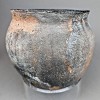
| Culture | Branch | Tradition | Ware | Type |
| Ancestral Pueblo: Greater Mogollon | Jornada Mogollon | Southern Jornada (El Paso) | El Paso Brown - Polychrome Ware | El Paso Brown |
Type Name: El Paso Brown |
|
| Period: | 200 A.D. - 1450 A.D. |
| Culture: | Ancestral Pueblo: Greater Mogollon |
| Branch: | Jornada Mogollon |
| Tradition: | Southern Jornada (El Paso) |
| Ware: | El Paso Brown - Polychrome Ware |
First posted by C. Dean Wilson 2012
El Paso Brown ware was defined by Lehmer (1948). This represents the overwhelmingly dominate pottery type in early assemblages distributed across much of the Southern Jornada region. El Paso Brown is sometimes distinguished from other Jornada Brown Ware types by the absence of or low degree of polish on either surface and the presence of large temper fragments that are often visible on the paste and surface (Runyon and Hedrick 1973).
Surface finishes are usually smoothed, rough, and unpolished with numerous visible pits, streaks, and striations. El Paso Brown pastes tend to be soft, and surfaces are often eroded and difficult to characterize. Walls are variable in thickness and there is often a relationship between thickness and abundance of temper with temper being larger and more abundant in thick sherds. Pastes profiles tend to either be dark gray across the wall or display a dark gray core between dark gray surface areas. Surface colors range from a dark gray, dark red, light brown to dark chocolate brown color. Temper is usually composed of granite or syenite, with feldspar, and sometimes biotitic mica (Miller 1995).
El Paso Brown appears to have been first produced sometime between A.D. 200 and 400. The distribution of this type is particularly widespread during early periods (pre-1050), where El Paso brown may dominate early assemblages in areas later dominated by Jornada Brown (Wilson 2003; Wiseman 1985). It is likely that El Paso Brown vessels were not produced in all the areas where it represents the dominant type including marginal areas where horticulture does not seem to have been practiced. The occurrence of this type in some in such areas seems to reflect widespread patterns of seasonal movement and exchange between groups with and without horticulture. Unpainted sherds displaying characteristics defined for this type occur at sites dating as late as A.D. 1450. Variation in forms and surface characteristics reflect the long production of similar vessel forms (Miller 1995; Whalen 1981; 1994). Given both surfaces of El Paso Brown vessels may be unpolished; it is often not possible to determine the vessel form to sherds not derived from rim or neck of a vessel. Early forms are dominated by seed jars, bowls, and narrow jars. Early forms of El Paso Brown exhibit pointed or pinched lips, while later forms exhibit more uniform walls with flat or rounded lips. These changes may reflect a shift to slightly larger and wider mouth vessels at about A.D. 1000. Other studies indicate gradual changes in El Paso Brown Ware that may include a decrease in temper size, and an increase in fineness of surface finish and surface hardness through time (Whalen 1994). While El Paso Brown was largely replaced by El Paso Polychrome vessels by A.D. 1250, these vessels are often only painted on the upper portion of the vessel. Unpainted examples from painted or polychrome forms tend to be much thinner than earlier examples of unpainted brown wares.
References:
Lehmer, Donald J.
1948 The Jornada Branch of the Mogollon., Social Science Bulletin 17. University of Arizona, Tucson.
Miller, Myles R.
1995 Ceramics of the Jornada Mogollon and Trans-Pecos Regions of West Texas. Bulletin of Texas Archaeological Society, Vol 666, pp 210-235, Austin.
Runyon, John W., and John A. Hedrick
1987 Pottery Types of the Southwest Federation of Archaeological Societies (SWFAS) Area. The Artifact 25(4):23–59.
Whalen, Michael E.
1981 The Origin and Evolution of Ceramics in Western Texas. Bulletin of the Texas Archaeological Society 52:215–229.
1994 Turquoise Ridge and Late Prehistoric Residential Mobility in the Desert Mogollon Region. Anthropological Papers 118. University of Utah Press, Salt Lake City.
Wilson, C. Dean
2003 Ceramics. In Salt Creek: Data Recovery at Seven Prehistoric Sites along US 285, Chaves and DeBaca Counties, New Mexico, by N. J. Akins, pp. 157–172. Archaeology Notes 298. Office of Archaeological Studies, Museum of New Mexico, Santa Fe.
Wiseman, Regge N.
1985 Proposed Changes in Some of the Taxonomic Sequences of the Jornada Branch of the Mogollon. The Artifact 23 (102). El Paso Archaeological Society, El Paso.
Related Photos
 © New Mexico Office of Archaeological Studies, a division of the New Mexico Department of Cultural Affairs.
© New Mexico Office of Archaeological Studies, a division of the New Mexico Department of Cultural Affairs.
The Center for New Mexico Archaeology
7 Old Cochiti Road
Santa Fe, NM 87507
505-476-4404
Fax: 505-476-4448




